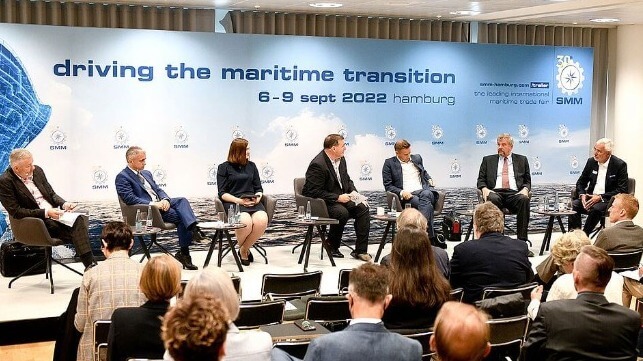At SMM 2022, Emissions Debate Turns Towards Solutions

SMM 2022 wrapped up on Friday, and the numbers show that the industry is happy to return to in-person events. Over the course of the week, more than 30,000 people came to the Hamburg Messe conference complex to check out suppliers, meet friends and customers, close deals - and, of course, to party. The first two days of the show were particularly packed with visitors, and some corporate presentations had standing room only.
The talk of the conference was decarbonization, of course, along with the engineering solutions to make it happen. The discussion is picking up speed in part for regulatory reasons: the Energy Efficiency Existing Ship Index (EEXI) and Carbon Intensity Indicator (CII) regulations take effect on January 1, and a large swathe of the world's merchant fleet will have to make changes in order to comply. One of the main retrofit solutions for the near term will be slow steaming, enforced with the use of a power limitation system (shaft power limitation). This simply limits how far the fuel rack moves, and it costs little to put it onto an existing vessel; for many ships it is just a software patch.
Other low-cost, high-return interventions include software systems that can provide guidance to crew on how to save fuel. There are many contenders, and they are all structured to give shoreside ship managers more insight into the vessel's status, giving the operator more control over how fuel is consumed.
Moving up the cost scale, auxiliary wind propulsion is having a moment, and there are multiple new entrants and multiple projects in progress. For the right vessel, the retrofit process is relatively straightforward - just adding more steel on deck - and the efficiency gains can be substantial. There is a side benefit, too: one vendor notes that the sail is the most visually noticeable low-carbon solution on the market. Every other option gets installed below the waterline or inside the hull.
The big outstanding questions are about the makeup of the future fuel mix, but there are signs of a rough consensus about what it might look like for the deep-sea fleet: LNG as a bridge fuel; green methanol as a first zero-carbon fuel, with limits to its scalability; and then green ammonia as a large-scale solution - when the R&D is done and the safety concerns are resolved. But there is no certainty on the timeline, availability or cost for these fuels, so owners have to aim at a moving dartboard if they place an order today. At SMM, engine manufacturers were keen to advertise future-proofed engines that are designed to run on conventional fuels now, but have provisions for later conversion.
Perhaps the most significant element of this discussion might be the fact that it was heard in every forum. Just a few years in the past, decarbonization might have been an aspiration; in conversations at SMM this year, it was the primary concern, and a swathe of new products were aimed squarely at it. As one senior class society executive observed, some owners are even making plans to track their shoreside suppliers' and customers' emissions (so-called Scope 2 and 3 emissions) in addition to their own. This is a sea change for the industry.
